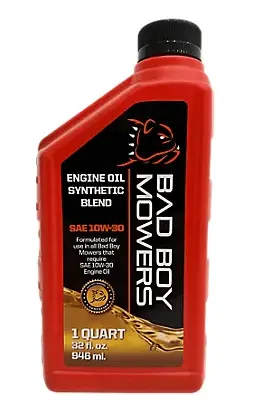Changing the oil in your Bad Boy mower keeps the engine lubricated, reduces wear, and helps it perform at its best. In this guide, we’ll walk you through the step-by-step process of performing an oil change on your Bad Boy mower, including the tools you’ll need and tips for success.
Bad Boy Mower Oil Change
Tools and Supplies You’ll Need
To perform an oil change on your Bad Boy mower, gather the following tools and supplies:
- Oil: Check your owner’s manual for the recommended oil type. Most Bad Boy mowers use SAE 10W-30 or 10W-40 synthetic oil, but this can vary by model.
- Oil Filter: Use the filter specified for your mower model (e.g., Bad Boy part number 063-8014-00 for many models).
- Oil Filter Wrench: To remove the old filter.
- Drain Pan: To catch the old oil.
- Socket Wrench or Hex Key: To remove the drain plug (size depends on your model).
- Funnel: For pouring new oil.
- Rags or Paper Towels: For cleanup.
- Gloves: To keep your hands clean and protected.
- Jack or Ramps: To elevate the mower for easier access to the drain plug (optional).
- Replacement Drain Plug Washer: If your model requires it.
Ensure you have the correct oil capacity (typically 2-3 quarts for most Bad Boy mowers) check below:
Bad Boy Mower OEM 10W‑30 Synthetic Blend Engine Oil

- Specifically formulated for Bad Boy mowers – ensures perfect compatibility with Kawasaki, Briggs, and Kohler engines used in these machines.
- Viscosity: 10W‑30 synthetic blend – delivers strong anti-wear protection, resists deposits, and keeps engines clean.
- Proven performance – comes straight from the factory, with high user satisfaction for smooth operation and longevity.
Step-by-Step Oil Change Process
Follow these steps to change the oil in your Bad Boy mower safely and effectively:
Step 1: Prepare the Mower
- Park on a Flat Surface: Place your mower on a level surface to ensure accurate oil drainage and filling.
- Turn Off the Engine: Ensure the engine is off and cool. A warm engine (not hot) is ideal for draining oil, as it flows more easily.
- Disconnect the Spark Plug: For safety, disconnect the spark plug wire to prevent accidental starts.
- Elevate the Mower (Optional): If needed, use a jack or ramps to access the oil drain plug more easily.
Step 2: Drain the Old Oil
- Locate the Drain Plug: The oil drain plug is typically located on the bottom of the engine. Refer to your manual for its exact position.
- Place the Drain Pan: Position a drain pan directly beneath the plug to catch the oil.
- Remove the Drain Plug: Use a socket wrench or hex key to loosen and remove the drain plug. Allow the oil to drain completely, which may take a few minutes.
- Inspect the Drain Plug: Check the plug and washer (if applicable) for damage. Replace the washer if worn.
Step 3: Replace the Oil Filter
- Locate the Oil Filter: The filter is usually near the engine, often accessible from the side or bottom.
- Remove the Old Filter: Use an oil filter wrench to loosen and remove the old filter. Be prepared for some oil to drip out.
- Prepare the New Filter: Before installing, apply a thin layer of new oil to the rubber gasket on the new filter to ensure a good seal.
- Install the New Filter: Screw the new filter into place by hand until snug, then tighten it slightly with the wrench (do not overtighten).
Step 4: Replace the Drain Plug
- Reinstall the Plug: Once the oil has fully drained, reinstall the drain plug with a new washer if required. Tighten securely, but avoid overtightening, as this can strip the threads.
- Clean Up: Wipe away any spilled oil with a rag.
Step 5: Add New Oil
- Locate the Oil Fill Cap: Find the oil fill cap on top of the engine.
- Add Oil: Using a funnel, slowly pour in the recommended amount of new oil. Check your manual for the exact capacity.
- Check the Oil Level: Use the dipstick to ensure the oil level is within the recommended range. Add more if needed, but avoid overfilling.
- Replace the Oil Fill Cap: Secure the cap tightly.
Step 6: Final Steps
- Reconnect the Spark Plug: Reattach the spark plug wire.
- Dispose of Old Oil: Pour the used oil into a sealed container and take it to a recycling center or auto shop that accepts used oil.
- Test the Mower: Start the engine and let it run for a minute to circulate the new oil. Check for leaks around the drain plug and filter.
- Record the Maintenance: Note the date and hours of operation in your maintenance log to track the next oil change.
Related Best Oil for a Lawn Mower(Top 5 PICKS 2025)
Tips for Success
- Use High-Quality Oil and Filters: Stick to Bad Boy-approved products to maintain warranty coverage and engine health.
- Check for Leaks: After the oil change, inspect the drain plug and filter for leaks during the test run.
- Maintain a Schedule: Set reminders for oil changes based on hours used or annually.
- Work in a Well-Ventilated Area: Avoid inhaling oil fumes and ensure proper ventilation.
- Consult Your Manual: Always refer to your Bad Boy mower’s manual for model-specific instructions, as engine types and oil requirements vary.
Related Bad Boy Mower Comparison Chart(Complete Models Comparison)
Common Mistakes to Avoid
- Overfilling the Oil: Too much oil can cause engine damage. Always check the dipstick.
- Using the Wrong Oil or Filter: This can reduce performance or void warranties.
- Skipping the Break-In Oil Change: New mowers need an oil change after the first 8 hours to remove manufacturing debris.
- Improper Disposal: Never pour used oil into the ground or trash. Always recycle it properly.
Related Are Bad Boy Mower Blades Reverse Thread?(Find Out Now)
Final words
Changing the oil in your Bad Boy mower is a straightforward task that pays off in the long run. With the right tools, a little time, and attention to detail, you can keep your mower’s engine running smoothly for years.
Regular oil changes, combined with other maintenance tasks like air filter cleaning and blade sharpening, will ensure your Bad Boy mower remains a reliable workhorse for all your lawn care needs.




